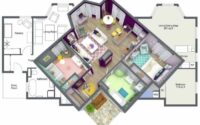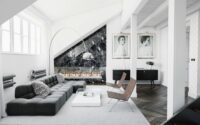American House Design Interior: A Guide to Style and Functionality
American house design interior encompasses a rich tapestry of styles, reflecting the nation’s diverse history and cultural influences. From the stately Colonial homes of the East Coast to the sprawling Ranch houses of the West, American residential architecture has evolved over centuries, embracing both traditional and modern aesthetics.
This guide delves into the key principles of American house design, exploring everything from architectural styles and interior design trends to the creation of functional and aesthetically pleasing living spaces. We’ll examine how color theory, balance, and proportion play a role in achieving a cohesive and inviting atmosphere, while also considering the impact of sustainable design practices and contemporary trends.
Outdoor Living Spaces: American House Design Interior
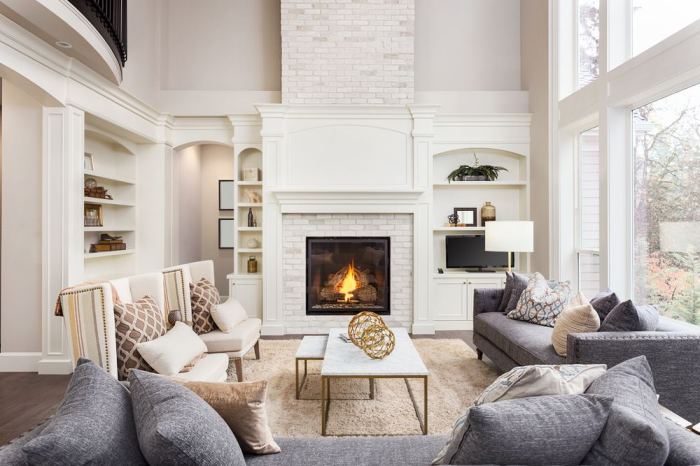
Outdoor living spaces are becoming increasingly popular in American homes, offering an extension of indoor living and a way to enjoy the outdoors comfortably. These spaces can be designed to accommodate various activities, from relaxing and entertaining to dining and cooking.
Designing an Outdoor Living Space
The design of an outdoor living space should be tailored to the specific needs and preferences of the homeowner. Consider the following elements:
Seating Arrangements
- Comfortable Seating:Choose furniture that is comfortable and durable, such as wicker, teak, or metal. Consider different seating options, such as sofas, armchairs, and ottomans, to provide flexibility and accommodate different group sizes.
- Fire Pit or Fireplace:A fire pit or fireplace can create a warm and inviting ambiance, especially during cooler evenings. It can also serve as a focal point for the space.
- Dining Area:If you plan on using the space for dining, include a table and chairs that are suitable for the size of your family and guests.
Landscaping Elements
- Plants and Flowers:Add greenery and color to your outdoor living space with plants and flowers. Consider using native species that are well-suited to your climate and soil conditions.
- Water Features:A fountain, pond, or waterfall can create a calming and relaxing atmosphere. Water features can also attract birds and other wildlife.
- Paths and Walkways:Paths and walkways provide access to different areas of the space and can help define different zones.
Lighting Fixtures
- Ambient Lighting:Use string lights, lanterns, or sconces to create a warm and inviting atmosphere.
- Task Lighting:Provide task lighting for areas where you need to read or work, such as a dining table or a reading nook.
- Accent Lighting:Highlight specific features, such as plants, sculptures, or architectural elements, with accent lighting.
Creating a Mood Board, American house design interior
A mood board is a visual representation of the desired aesthetic for your outdoor living space. It can help you visualize the overall design and select materials, textures, and colors that complement your home’s style.
Materials and Textures
- Natural Materials:Use natural materials such as wood, stone, and brick to create a warm and inviting ambiance. These materials can be used for furniture, flooring, walls, and accents.
- Textiles:Incorporate textiles such as cushions, throws, and rugs to add comfort and texture. Choose fabrics that are durable and weather-resistant.
- Metal:Metal accents can add a touch of modern sophistication. Consider using metal for furniture, lighting fixtures, and sculptures.
Colors
- Neutral Colors:Neutral colors such as white, beige, gray, and brown provide a calming and versatile backdrop for other colors and patterns.
- Bold Colors:Add pops of color with accents such as cushions, throw pillows, and flowers. Consider using colors that complement the colors of your home.
- Natural Colors:Use natural colors such as green, blue, and brown to create a sense of harmony with the surrounding landscape.
Outdoor Furniture and Accessories
Outdoor furniture and accessories can enhance the functionality and style of your outdoor living space.
Styles
- Traditional:Traditional outdoor furniture typically features classic designs, such as wicker chairs and wooden tables. These pieces often have a timeless appeal and can add a touch of elegance to any space.
- Modern:Modern outdoor furniture is characterized by clean lines, minimalist designs, and sleek materials such as metal and glass. These pieces can create a sophisticated and contemporary look.
- Rustic:Rustic outdoor furniture often features natural materials such as reclaimed wood and weathered metal. These pieces can add a touch of warmth and character to any space.
Functionalities
- Seating:Outdoor seating options include sofas, chairs, ottomans, and swings. Choose furniture that is comfortable and durable, and that can accommodate different group sizes.
- Dining:Outdoor dining tables and chairs allow you to enjoy meals al fresco. Consider using a table that is large enough to accommodate your family and guests.
- Storage:Outdoor storage chests and cabinets can help keep your outdoor space organized and clutter-free. Choose storage solutions that are weather-resistant and secure.
Contemporary Trends
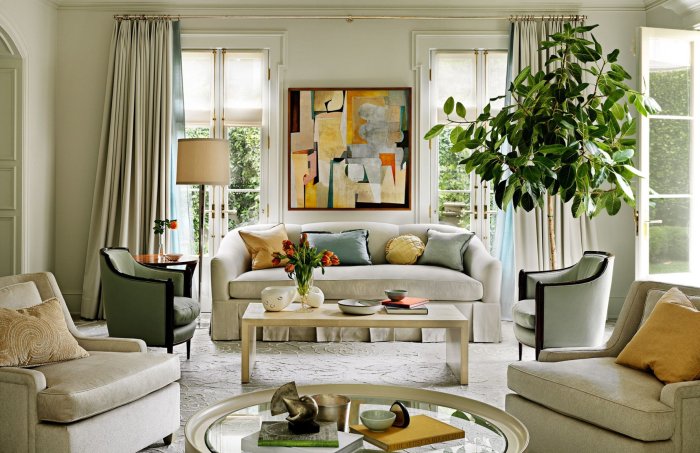
American house interior design is constantly evolving, reflecting changing lifestyles, technological advancements, and a growing awareness of sustainability. This dynamic landscape is shaped by a blend of functional needs, aesthetic preferences, and emerging trends.
Influence of Social Media and Lifestyle Trends
Social media platforms like Instagram and Pinterest have significantly impacted American home interiors. These platforms serve as a visual repository of design inspiration, showcasing a wide array of styles and trends. The constant flow of images and ideas has led to a heightened awareness of design aesthetics, with homeowners seeking to create spaces that are both visually appealing and reflect their personal style.
American house design interiors often reflect a blend of styles, from traditional to modern. A popular size for a comfortable home is 1200 square feet, which allows for efficient use of space. For those looking to design a 1200 square feet house interior, this resource offers helpful tips and ideas.
Whether it’s a cozy cottage or a modern farmhouse, American house design interiors can be both stylish and functional.
Furthermore, lifestyle trends like minimalism, wellness, and sustainability have influenced design choices, with homeowners opting for clean lines, natural materials, and eco-friendly furnishings.
Emerging Trends in Materials, Styles, and Technologies
- Biophilic Design:This trend emphasizes incorporating elements of nature into the home, promoting a sense of well-being and connection to the outdoors. Examples include using natural materials like wood and stone, incorporating plants and greenery, and designing spaces with views of nature.
- Smart Home Technology:Smart home technology is becoming increasingly integrated into American homes, offering convenience, energy efficiency, and enhanced security. This includes features like voice-activated lighting, automated thermostats, and smart appliances that can be controlled remotely.
- Sustainable Materials:As environmental consciousness grows, homeowners are increasingly opting for sustainable materials like bamboo, reclaimed wood, and recycled glass. These materials not only reduce the environmental impact of construction but also add a unique character to the interior.
- Multifunctional Spaces:With limited living space becoming more common, homeowners are looking for furniture and designs that maximize functionality. This includes using convertible furniture, incorporating built-in storage, and creating multi-purpose rooms that serve multiple functions.
Personalization and Expression
An American house is more than just a dwelling; it’s a reflection of the homeowner’s personality, style, and aspirations. Personalization is a defining characteristic of American home interiors, allowing residents to create spaces that are truly their own.
The Role of Art, Decor, and Accessories
Art, decor, and accessories play a crucial role in shaping the character and ambiance of an American home. They add visual interest, evoke emotions, and tell a story about the homeowner’s taste and lifestyle.
- Art:Paintings, sculptures, photographs, and other forms of art can transform a blank wall into a focal point, expressing the homeowner’s artistic preferences and cultural influences. For instance, a collection of abstract paintings might reflect a modern aesthetic, while a family portrait might represent traditional values.
American house design interiors often embrace a sense of spaciousness and functionality. Whether it’s a sprawling ranch or a cozy cottage, the focus is on creating comfortable living spaces. For those looking to maximize space within a smaller footprint, exploring 1000 sq ft house interior design can provide valuable inspiration.
These designs prioritize smart layouts and clever storage solutions to make the most of every square foot, ensuring a comfortable and stylish living environment, even within a smaller space. This attention to detail and efficient use of space is a hallmark of American home design, regardless of the square footage.
- Decor:Decorative elements, such as throw pillows, rugs, curtains, and lighting fixtures, contribute to the overall style and comfort of a space. They can introduce patterns, textures, and colors that enhance the visual appeal and create a specific mood.
- Accessories:Accessories like vases, candles, books, and plants add personality and warmth to a room. They can be strategically placed to create visual balance, enhance the flow of the space, and provide a sense of personal touch.
Cultural Influences on Interior Design
American homes often incorporate elements from diverse cultures, reflecting the country’s multicultural heritage and global interconnectedness. This fusion of styles adds richness and depth to interior design, creating unique and eclectic spaces.
- Global Influences:Many homeowners incorporate furniture, textiles, and decorative objects from different parts of the world, such as Moroccan lanterns, Japanese screens, or Indian textiles. These elements introduce a touch of exoticism and global flair to the interior.
- Ethnic Influences:American homes may reflect the homeowner’s ethnic heritage through the use of traditional art, furniture, or decorative motifs. For example, a Mexican-inspired home might feature colorful Talavera tiles, vibrant textiles, and traditional Mexican furniture.
Outcome Summary
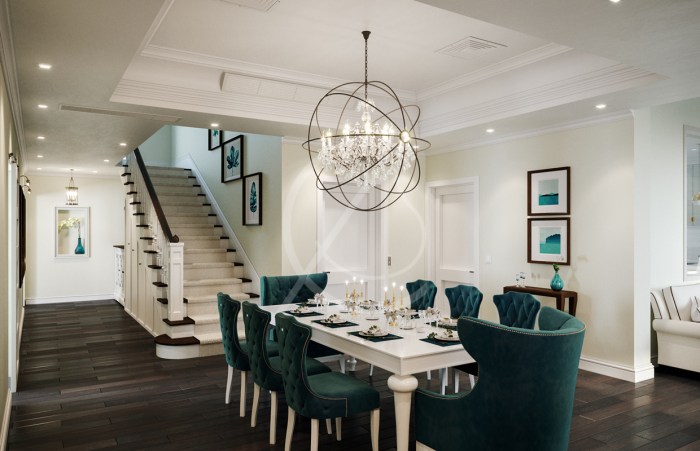
Designing an American house interior is a journey of personal expression, blending functionality with style to create a space that truly reflects its inhabitants. By understanding the historical evolution of American design, embracing key principles, and staying informed about current trends, you can create a home that is both beautiful and comfortable, a sanctuary that celebrates the unique character of American living.
Query Resolution
What are some popular American house design styles?
Popular styles include Colonial, Victorian, Craftsman, Ranch, and Contemporary.
How can I incorporate my personal style into my American house design?
Use color palettes, furniture, and accessories that reflect your taste and interests. Incorporate artwork, family heirlooms, and meaningful objects to personalize the space.
What are some tips for creating a sustainable American house interior?
Choose eco-friendly materials, such as bamboo flooring or recycled glass countertops. Opt for energy-efficient appliances and lighting. Consider using natural light and ventilation to reduce energy consumption.


